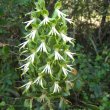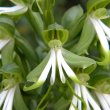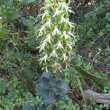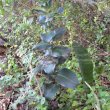Bonatea speciosa
| Botanical Name | Bonatea speciosa |
|
| Family | Orchidaceae - The orchid family. |
|
| Pronunciation | bon-AT-ee-uh spee-see-OH-suh |
|
| Common Name(s) |
English: Green wood orchid; Phantom orchid
Afrikaans: Moederkappie; Oktoberlelie
|
|
| Plant Group |
|
|
| Plant Size | ||
| Position |
|
|
| General Information |
|
|
| Specific Information | Bonatea speciosa is a deciduous terrestrial orchid, usually growing 0.4-0.6 m in height but is known to reach up to a meter or more. During the growing season a robust stem with broad, very dark green leaves, rises from the ground. The flower stem carries a few to many medium-sized to large, green and white, sweetly scented flowers, which are very complicated in shape and look somewhat spider-like. The flower is pollinated by hawk moths. At the beginning of the dormant season, the above-ground parts dry off completely, and the plants rest, drawing nutrients from their elongated storage tubers. |
|
| Ad Break | ||
| Flowers | ||
| Description | spider-like orchid flower |
|
| Season |
|
|
| Colour |
|
|
| Growth Rate |
|
|
| Plant Uses |
|
|
| Distribution and Habitat | from Lambert's Bay in the Western Cape, through a narrow coastal strip in the Eastern Cape, north to KwaZulu-Natal, and further into southern Mozambique, in Fynbos, Indian Ocean Coastal Belt, Eastern Cape.forest, on forest margins, in open woodland and occasionally in open savanna in sandy soil |
|
| Planting Suggestions | Bonatea speciosa needs well drained soil or soil mixture to prevent the roots from rotting, but it is reportedly one of the easiest orchids to grow. Plants cultivated in garden beds require a shady or semi-shady spot. In climates where temperatures make it unsuitable for an outdoor environment, grow this plant in pots or containers so that the plants can be moved indoors during inclement weather. A growing medium of equal parts of fibrous peat, loam, coarse sand and fine bark, with a layer of drainage material at the bottom, should be used. The soil should be kept fairly dry in the dormant season, but must not dry out completely. Bonateas do not thrive in high humidity. Acceptable temperatures would range between 5ºC and 30ºC. The most common cultivation problem is rotting of the tubers, stems or roots due to over-watering. Try to avoid wetting the leaves and new shoots altogether. Plants of Bonatea speciosa cannot be divided and propagation from seed is complicated, requiring the facilities of a laboratory with sterile working conditions.
|
|
| Medicinal Uses | No data found. |
|
| Ad Break | ||








Comments
Bonatea speciosa
Bonatea speciosa also occurs in the Free State Province, probably mainly in the eastern parts. It grows on densely wooded faces of hills and mountains. I have found it abundantly in the Clocolan district, near the Lesotho border, also some plants in the Marquard district and it grows wild in the Free State National Botanical Garden. The plants flower in March. Picture taken 13 March 2014 - flowers will open within a few days.
Mistaken identity?
Hi Dawie
Thanks for your clear description and photo. Unfortunately I must disagree with your identification.
Orchids are extremely climate sensitive and Bonatea speciosa would not survive in the areas you have described. They are found strictly along the Eastern coast of South Africa. The flowering time for Bonatea is from winter to summer, not autumn, and the leaves and plant structure are quite different - compare the leaves in your picture with those of the Bonatea.
Considering there are 433 species of orchid in South Africa, it is very easy to make an error in identification. I am unable to identify this orchid from the picture but I suspect it may be a member of the genus Habenaria, of which there are 30 species, some of which are found in the Free State.
To correctly identify this orchid, the only suggestion I can make is to email the picture to the Free State National Botanical Gardens at FSNBG@sanbi.org.za. As it grows wild in the gardens, they should be able to identify this orchid from your picture and the list of places you have seen it.
If you do find the correct ID, do please let me know the name.
Kind regards
Lorraine
Bonatea speciosa - identifisering
Lorraine, ek is geneig om saam met Dawie te stem mbt die identifiseering van Bonatea speciosa. Ek woon Noord-Oos van Pretoria in die De Wild omgewing en het 7 soortgelyke plante op my kleinhoewe wat identies is van die wat Dawie ge plaas het en deur PlantZAfrika beskryf word. Hulle groei onder en tussen die soetdoring en ander bome. Die grond is sand-leem. Bonatea speciosa se kappie is ook oorwegend groen terwyl Bonatea Habenaria genus se kappies wit is. Hier by my blom hulle van einde Januarie tot einde Maart. Dus in die koeler somer maande. Ek neem aan dat hulle redelik goed aanpasbaar is en het selfs 2015/2016 se uitermatige hute (tot 44grade C)oorleef. Hoop dit help. Groetnis. (As ek reg ontou het ek hule as kind ook in die waterberge (Noord-Transvaal) waar geneem)
Bonatea speciosa - identifisering
Dag Willem
Baie dankie vir jou verklaring.
Groete
Lorraine
Discuss this plant
Share knowledge, ask a question or give an experience.